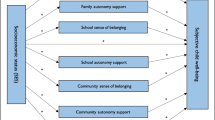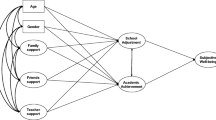Abstract
The present study investigates how the changing socioeconomic conditions in Russia and Ukraine affect the psychological well-being of high-school adolescents in these countries. Six indexes of psychological well-being, the adolescents’ perception of the economic conditions in their families, perceived parental practices (care and autonomy providing), and perceived social support were measured in 1999 and 2007. Macro-level socioeconomic conditions in Russia and Ukraine, as well as the adolescents’ perception of the economic conditions in their family, substantially improved from 1999 to 2007. However, the psychological well-being of the adolescents, as well as their perception of parental practices and the social support received from parents, peers, and teachers did not change. Russian adolescents consistently reported higher self-esteem and school competence than their Ukrainian peers, as well as higher parental care and autonomy providing, and higher social support received from peers. At the individual level, perceived parental care and autonomy providing, as well as perceived social support from parents, peers, and teachers were the major contributors to the adolescents’ psychological well-being. The obtained results are discussed in light of the conservation of resources and ecological systems theories.
Similar content being viewed by others
Notes
These indexes were chosen because: (1) they reflect a wide range of socioeconomic parameters; (2) they are provided by international organizations and their calculation is based on well-established scientific methodology; (3) data for these indexes existed for both 1999 and 2007.
The international public organization Transparency International defines corruption as “the abuse of public office for private gain.” The Corruption Perceptions Index orders the countries of the world according to “the degree to which corruption is perceived to exist among public officials and politicians.” The Corruption Perceptions Index is a composite of independent surveys. A higher score means less perceived corruption. A score of five and above out of ten is a “clean score” demonstrating that a country is not corrupt [51].
The international public organization Reporters Without Borders compiles Press Freedom Index by asking its partner organizations (14 freedom of expression groups from around the world) and its network of 130 correspondents, as well as journalists, researchers, legal experts and human rights activists, to answer 50 questions designed to assess a country’s level of press freedom. The survey asks questions about direct attacks on journalists and the media as well as other indirect sources of pressure against the free press. The lower the score of the Index, the higher the freedom of press [37]. This index began to be calculated from 2002; therefore, data regarding 1999 does not exist.
The Human Development Index reflects achievements in the most basic human capabilities—leading a long life, being knowledgeable, and enjoying a decent standard of living. Three variables were chosen to represent these dimensions—life expectancy, educational attainment, and income. The Human Development Index is the product of a selected team of leading scholars, development practitioners, and members of the Human Development Report Office of the United Nations Development Program [52]
The higher number of the adolescents’ siblings in 2007 probably reflects a success of governmental policy stimulating child birth in both Russia and Ukraine [14].
Parental consent was not obtained in this study, because of a cultural norm existing in Russia and Ukraine that leaves the decision regarding participation in a study to adolescents. Psychologists conducting the study approached the adolescents’ parents asking them for their consent. However, the parents answered that this decision is a sole prerogative of the adolescents. However, the school principal’s permission for conducting a study was required according to the Russian and Ukrainian law. It was received after the content of the questionnaires was agreed upon with the school principals.
Since externalizing and internalizing problems scores of the YSR were highly correlated with the total problems score, only the total problem score was used for correlation analysis. Correlation analyses are presented for the 2007 measurement; however, the obtained correlation coefficients were very similar in 1999 and 2007. Since the patterns of correlations in the Russian and Ukrainian samples were similar, the two samples were pooled.
References
Aberg M, Sandberg M (2003) Social capital and democratization: roots of trust in post-communist Poland and Ukraine. Ashgate Publishing, Surrey
Achenbach TM (1991) Manual for the youth self-report and profile. Department of Psychiatry, University of Vermont, Burlington, VT
Achenbach TM (2004) Cross-cultural perspectives on developmental psychopathology. In: Gielen UP, Roopnarine J (eds) Childhood and adolescence: cross-cultural perspectives and applications. Praeger, Westport, pp 411–430
Achenbach TM, Dumenci L, Rescorla LA (2003) Are American children’s problems still getting worse? A 23-year comparison. J Abnorm Child Psychol 31(1):1–11
Aneshensel CS, Rutter CM, Lachenbruch PA (1991) Social structure, stress, and mental health: competing conceptual and analytic models. Am Sociol Rev 56(2):166–178
Baker P, Glasser S (2007) Kremlin rising: Vladimir Putin’s Russia and the end of revolution. Potomac Books, Dulles
Balatsky G, Diener E (1993) Subjective well-being among Russian students. Soc Indic ReS 28:225–243
Bobak M, Pikhart H, Hertzman C, Rose R, Marmot M (1998) Socioeconomic factors, perceived control and self-reported health in Russia: a cross-sectional survey. Soc Sci Med 47(2):269–279
Bronfennbrenner U (1989) Ecological systems theory. In: Vasta R (ed) Six theories of child development, vol 6. JAI Press, Greenwich, pp 187–250
Cockerham WC, Hinote BP, Abbott P (2006) Psychological distress, gender, and health lifestyles in Belarus, Kazakhstan, Russia, and Ukraine. Soc Sci Med 63:2381–2394
Collishaw S, Maughan B, Goodman R, Pickles A (2004) Time trends in adolescent mental health. J Child Psychol Psychiatry 45(8):1350–1362
Coutsoukis P (2007) World fact book: country ranks. http://www.theodora.com/wfb/
Diener E, Diener M, Diener C (1995) Factors predicting the subjective well-being of nations. J Personality Soc Psychol 69(5):851–864
Felgenhauer P (2008) Russia will regain demographic, economic, and military strength, Putin claims. Eurasia Daily Monitor. http://www.jamestown.org/edm/article.php?article_id=2372804
Garbarino J (1999) Lost boys: why our sons turn violent and how we can save them. Anchor books, New York
Gibbons JL (2004) Adolescents in the developing world. In: Gielen UP, Roopnarine J (eds) Childhood and adolescence: cross-cultural perspectives and applications. Praeger, Westport, pp 255–276
Gilmore ABC, McKee M, Rose R (2002) Determinants of and inequalities in self-perceived health in Ukraine. Soc Sci Med 55:2177–2188
Goodman R, Slobodskaya H, Knyazev G (2005) Russian child mental health: a cross-sectional study of prevalence and risk factors. Eur Child Adolesc Psychiatry 14(1):28–33
Goodwin R, Nizharadze G, Luu LAN, Kosd E, Emelyanova T (2001) Social support in changing Europe: an analysis of three post-communist nations. Eur J Soc Psychol 31:379–393
Goodwin R, Allen P, Nizharadze G, Emelyanova T, Dedkova N, Saenko Y, Bugrova I (2002) Fatalism, social support, and mental health in four former Soviet cultures. Personality Soc Psychol Bull 28(9):1166–1171
Grob A, Little TD, Wanner B, Wearing AJ (1996) Adolescents’ well-being and perceived control across 14 sociocultural contexts. J Personality Soc Psychol 71(4):785–795
Grogan L (2006) Alcoholism, tobacco, and drug use in the countries of Central and Eastern Europe and the former Soviet Union. Subst Use Misuse 41:567–571
Hayo B, Seifert W (2003) Subjective economic well-being in Eastern Europe. J Econ Psychol 24:329–348
Hays RD, DiMatteo MR (1987) A short-form measure of loneliness. J Personality Assess 51:69–81
Helmreich R, Stapp J (1974) Short forms of the Texas Social Behavior Inventory (TSBI), an objective measure of self-esteem. Bull Psychon Soc 4(5A): 473–475
Hobfoll SE (1989) Conservation of resources: a new attempt to conceptualizing stress. Am Psychol 44(3):513–524
Hobfoll SE, Lilly R (1993) Resource conservation as a strategy for community psychology. J Commun Psychol 21:128–148
Hofstede G, Hofstede GJ (2004) Cultures and organizations: software of the mind. McGraw-Hill, New York
International Center for Prison Studies (2007) World prison brief. http://www.prisonstudies.org
Interstate Statistical Committee of the CIS (2008) Database statistics of the CIS. http://www.cisstat.com/eng/index.htm#statinfo
Jose PE, D’Anna CA, Cafasso LL, Bryant FB, Chiker V, Gein N, Zhezmer N (1998) Stress and coping among Russian and American early adolescents. Dev Psychol 34(4):757–769
Kassinove H, Sukhodolsky DG (1995) Optimism, pessimism and worry in Russian and American children and adolescents. J Soc Behav Personality 10(1):157–168
Knyazev GG, Slobosdkaya HR, Safronova MV, Kinsht IA (2002) School adjustment and health in Russian adolescents. Psychol Health Med 7(2):143–155
Marsh HW, Byrne BM, Shavelson RJ (1988) A multifaceted academic self-concept: its hierarchical structure and its relation to academic achievement. J Educational Psychol 80(3):366–380
Offer D, Ostrov E, Howard KI (1982) The Offer Self-Image Questionnaire for adolescents: a manual, 3rd edn. Michael Reese Hospital and Medical Center, Chicago
Parker G, Tupling H, Brown LB (1979) A parental bonding instrument. Br J Med Psychol 52:1–10
Reporters without Borders (2007) Press freedom index. http://www.rsf.org/article.php3?id_article=24025
Rohner R (1986) The warmth dimension. Sage, Newbury Park
Ruchkin VV, Eisemann M, Hagglof B, Cloninger CR (1998) Interrelations between temperament, character, and parental rearing in male delinquent adolescents in Northern Russia. Compr Psychiatry 39(4):225–230
Safro S, Ponizovsky A (1996) The relationship between self-ratings and mothers’ ratings of behavioral problems among recent adolescent immigrants to Israel. Child Family Behav Ther 18(4):41–48
Scheer SD, Unger DG (1998) Russian adolescents in the era of emergent democracy: the role of family environment in substance use and depression. Family Relat 47(3):297–303
Schwartz SH (2004) Mapping and interpreting cultural differences around the world. In: Vinken H, Soeters J, Ester P (eds) Comparing cultures: dimensions of culture in comparative perspective. Brill, Leiden, pp 43–73
Shevtsova L (2005) Putin’s Russia, Revised edition. Carnegie Endowment for International Peace
Shteyn M, Schumm JA, Vodopianova N, Hobfoll SE, Lilly R (2003) The impact of the Russian transition on psychosocial resources and psychological distress. J Commun Psychol 31(2):113–127
Slobodskaya HR (1999) Competence, emotional and behavioral problems in Russian adolescents. Eur Child Adolesc Psychiatry 8:173–180
Tafarodi RW, Swann WB (1995) Self-liking and self-competence as dimensions of global self-esteem: initial validation of a measure. J Personality Assess 65(2):322–342
Tartakovsky E (2007) A longitudinal study of acculturative stress and homesickness: high-school adolescents immigrating from Russia and Ukraine to Israel without parents. Soc Psychiatry Psychiatric Epidemiol 42(6):485–494
Tartakovsky E (2009) The psychological well-being of unaccompanied minors: a longitudinal study of adolescents immigrating from Russia and Ukraine to Israel without parents. J Res Adolesc 19(2):177–204
Tavits M (2008) Representation, corruption, and subjective well-being. Comp Polit Stud 41(12):1607–1630
The Nuffield Foundation (2004) Time trends in adolescent well-being. Seminars on children and families: evidence and implications. http://www.nuffieldfoundation.org/fileLibrary/pdf/2004_seminars_childern_families_adolescents_and_wellbeing001.pdf
Transparency International (2007) Corruption perceptions index. http://www.transparency.org/policy_research/surveys_indices/cpi/2007
United Nation Development Program, UNDP (2007) Human development index. http://www.hdr.undp.org/en/statistics
Van IJzendoorn MH, Bakermans-Kranenburg MJ, Sagi-Schwartz A (2006) Attachment across diverse sociocultural contexts: the limits of universality. In: Rubin KH, Chung OB (eds) Parenting beliefs, behaviors, and parent-child relations: a cross-cultural perspective, Chap 5. Psychology Press, New York, pp 107–143
Verhulst FC, Van der Ende J, Rietbergen A (1997) Ten-year time trends of psychopathology in Dutch children and adolescents: no evidence for strong trends. Acta Psychiatr Scand 96:7–13
Verhulst FC, Achenbach TM, Ende J, Erol N, Lambert MC, Leung PWL, Silva MA, Zilber N, Zubrich SR (2003) Comparisons of problems reported by youths from seven countries. Am J Psychiatry 160:1479–1485
White A (2007) A global projection of subjective well-being: a challenge to positive psychology? Psychtalk 56:17–20. http://www.le.ac.uk/users/aw57/world/sample.html
Yakovlev A (1996) Reformation in Russia. Maariv, Tel Aviv. In Hebrew
Zilber N (1999) Preliminary results of YSR in the Israeli sample. Unpublished research report. JDC—Falk Institute, Jerusalem
Zimet GD, Dahlem NW, Zimet SG, Farley GK (1988) The multidimensional scale of perceived social support. J Personality Assess 52(1):30–41
Acknowledgments
The author is profoundly thankful to the Russian and Ukrainian psychologists who helped to conduct this study. The author is also grateful to the adolescents who participated in this study.
Author information
Authors and Affiliations
Corresponding author
Rights and permissions
About this article
Cite this article
Tartakovsky, E. Children of perestroika: the changing socioeconomic conditions in Russia and Ukraine and their effect on the psychological well-being of high-school adolescents. Soc Psychiat Epidemiol 45, 25–37 (2010). https://doi.org/10.1007/s00127-009-0037-1
Received:
Accepted:
Published:
Issue Date:
DOI: https://doi.org/10.1007/s00127-009-0037-1




